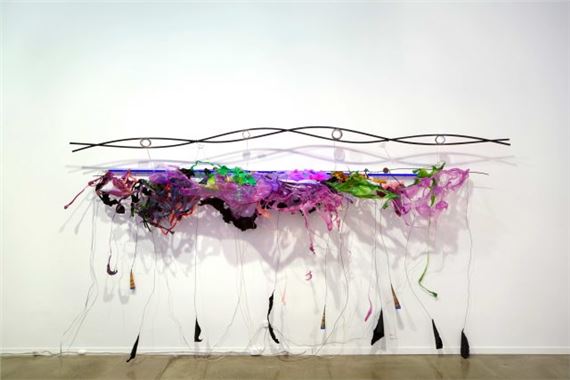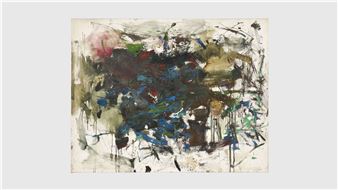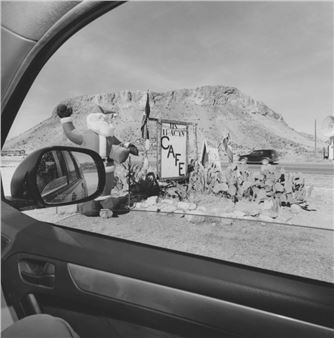Anonymous Was A Woman: The First 25 Years
The Grey Art Museum at New York University presents Anonymous Was A Woman: The First 25 Years, an exhibition celebrating recipients of the titular grant for mid-career women artists living and working in the United States. On view from April 1 to July 19, 2025, at 18 Cooper Square, this ambitious exhibition invites reflection on a quarter century of artistic achievement tied to the Anonymous Was A Woman (AWAW) grant program, which, since 1996, has supported women artists over the age of 40 with unrestricted awards. Six years in the making, Anonymous Was A Woman is organized by the Grey Art Museum at NYU and guest curated by Nancy Princenthal and Vesela Sretenović.
Featuring some 50 artworks by 41 of the 251 award recipients from when the grant was inaugurated in 1996 through 2020, the exhibition showcases a range of media and subjects by artists including Jeanne Silverthorne (AWAW 1996), Laura Aguilar (AWAW 2000), Senga Nengudi (AWAW 2005), Mary Heilmann (AWAW 2006), An-My Lê (AWAW 2006), Carrie Mae Weems (AWAW 2007), Ida Applebroog (AWAW 2009), Jungjin Lee (2011), Janine Antoni (AWAW 2014), and Jennifer Wen Ma (AWAW 2019), among others. With each year represented by at least one artist, the exhibition includes works created within a few years of their grant, demonstrating the significance of the award to the artist’s growth. “Nancy and I sought to create a visually compelling and intellectually stimulating exhibition that balances work by well-established and lesser-known artists. We also wanted to highlight leaps in production that the grant made possible, both practically—many artists were enabled to try new materials and processes—and conceptually,” Sretenović says. All 251 artists are represented in a publication accompanying the exhibition, which also includes critical essays about the awardees by Princenthal, Sretenović, and other women scholars.
Visitors to Anonymous Was A Woman will encounter works that trace the development of contemporary art practice over the last twenty-five years, addressing issues of identity and community; the position of women artists in society; the shifting value of craft; the changing possibilities for installation and time-based media; as well as the many uses of anonymity. Flamethrower, for example, a painting by Carrie Moyer (AWAW 2009) demonstrates the artist’s characteristic high-gloss surfaces and curvaceous, colorful forms, and challenges gendered conventions of abstraction. Rona Pondick (AWAW 2016), also featured in the exhibition, has used her own body to create self-portraits in various materials—such as the colored molded resin of Magenta Swimming in Yellow—that are at once deeply personal and anonymizing. Likewise, Elizabeth King (AWAW 2014) often references her own body when creating precisely moveable, half-scale figurative sculptures and combining them with stop-motion animation, as in Feints and Sleights.

Recommended for you
The Grey Art Museum at New York University presents Anonymous Was A Woman: The First 25 Years, an exhibition celebrating recipients of the titular grant for mid-career women artists living and working in the United States. On view from April 1 to July 19, 2025, at 18 Cooper Square, this ambitious exhibition invites reflection on a quarter century of artistic achievement tied to the Anonymous Was A Woman (AWAW) grant program, which, since 1996, has supported women artists over the age of 40 with unrestricted awards. Six years in the making, Anonymous Was A Woman is organized by the Grey Art Museum at NYU and guest curated by Nancy Princenthal and Vesela Sretenović.
Featuring some 50 artworks by 41 of the 251 award recipients from when the grant was inaugurated in 1996 through 2020, the exhibition showcases a range of media and subjects by artists including Jeanne Silverthorne (AWAW 1996), Laura Aguilar (AWAW 2000), Senga Nengudi (AWAW 2005), Mary Heilmann (AWAW 2006), An-My Lê (AWAW 2006), Carrie Mae Weems (AWAW 2007), Ida Applebroog (AWAW 2009), Jungjin Lee (2011), Janine Antoni (AWAW 2014), and Jennifer Wen Ma (AWAW 2019), among others. With each year represented by at least one artist, the exhibition includes works created within a few years of their grant, demonstrating the significance of the award to the artist’s growth. “Nancy and I sought to create a visually compelling and intellectually stimulating exhibition that balances work by well-established and lesser-known artists. We also wanted to highlight leaps in production that the grant made possible, both practically—many artists were enabled to try new materials and processes—and conceptually,” Sretenović says. All 251 artists are represented in a publication accompanying the exhibition, which also includes critical essays about the awardees by Princenthal, Sretenović, and other women scholars.
Visitors to Anonymous Was A Woman will encounter works that trace the development of contemporary art practice over the last twenty-five years, addressing issues of identity and community; the position of women artists in society; the shifting value of craft; the changing possibilities for installation and time-based media; as well as the many uses of anonymity. Flamethrower, for example, a painting by Carrie Moyer (AWAW 2009) demonstrates the artist’s characteristic high-gloss surfaces and curvaceous, colorful forms, and challenges gendered conventions of abstraction. Rona Pondick (AWAW 2016), also featured in the exhibition, has used her own body to create self-portraits in various materials—such as the colored molded resin of Magenta Swimming in Yellow—that are at once deeply personal and anonymizing. Likewise, Elizabeth King (AWAW 2014) often references her own body when creating precisely moveable, half-scale figurative sculptures and combining them with stop-motion animation, as in Feints and Sleights.
Related articles
The Grey Art Museum at New York University presents Anonymous Was A Woman: The First 25 Years, an exhibition celebrating recipients of the titular grant for mid-career women artists living and working in the United States.
This elegantly composed exhibition celebrates 25 years’ of awards to female artists by Anonymous Was a Woman and emphasises how creative practice has changed over time.

 ARTISTS
ARTISTS















